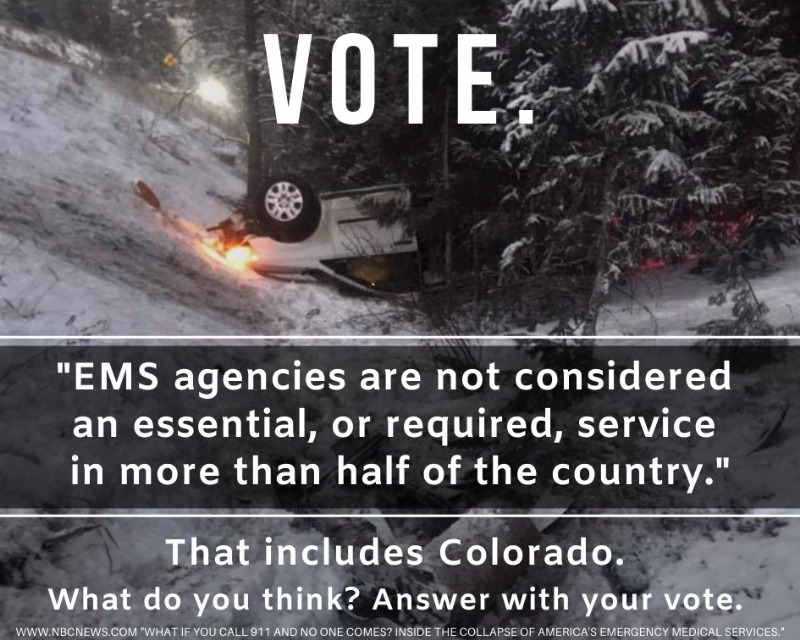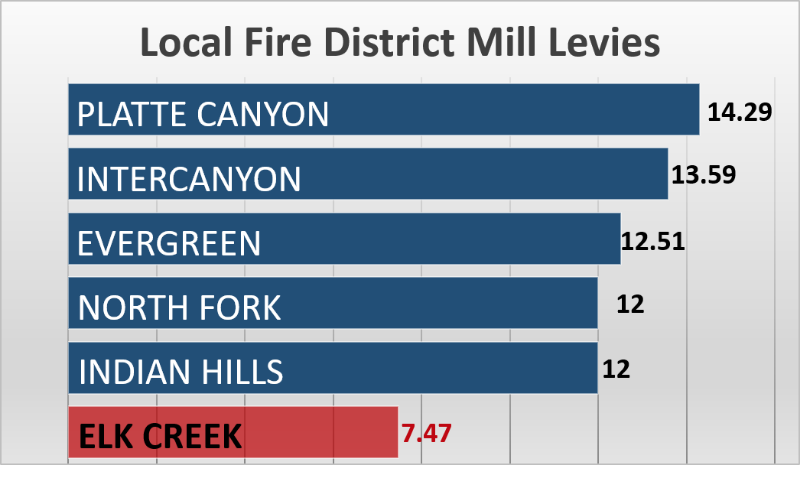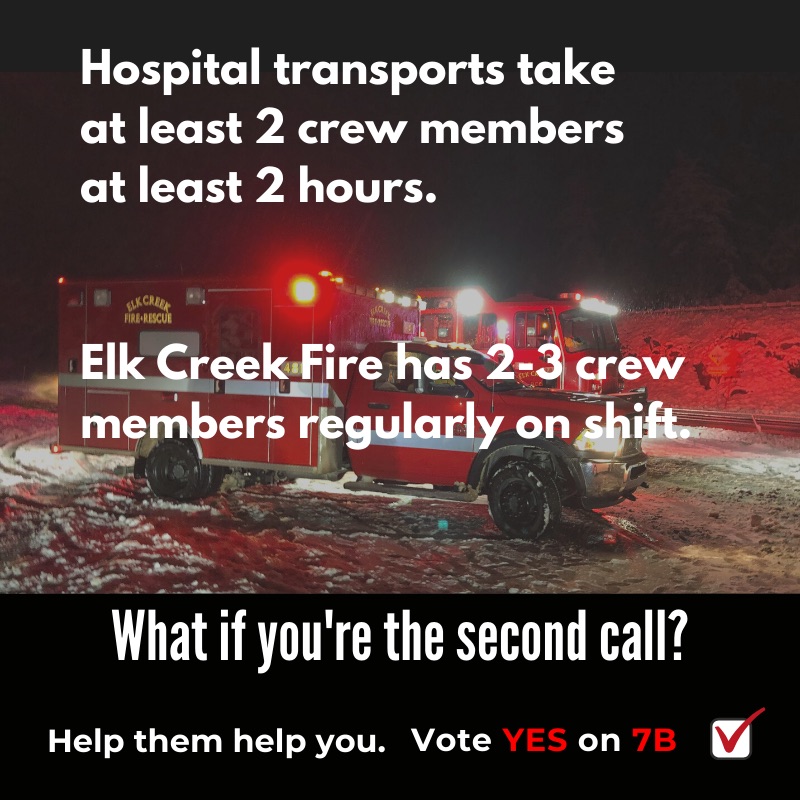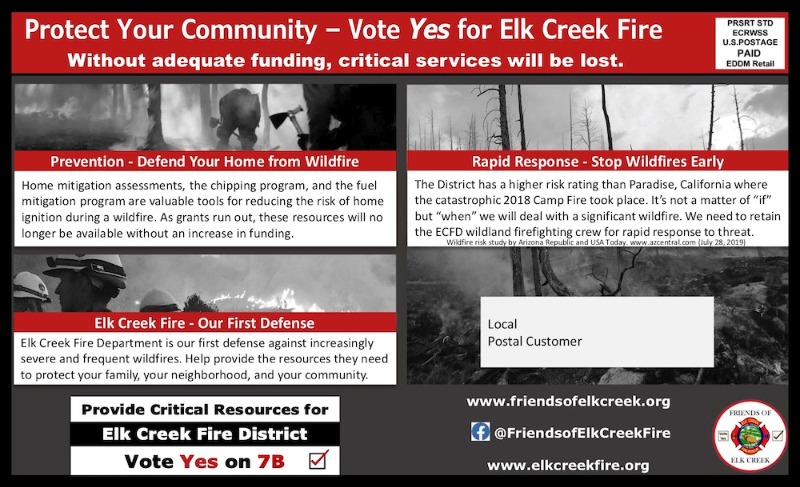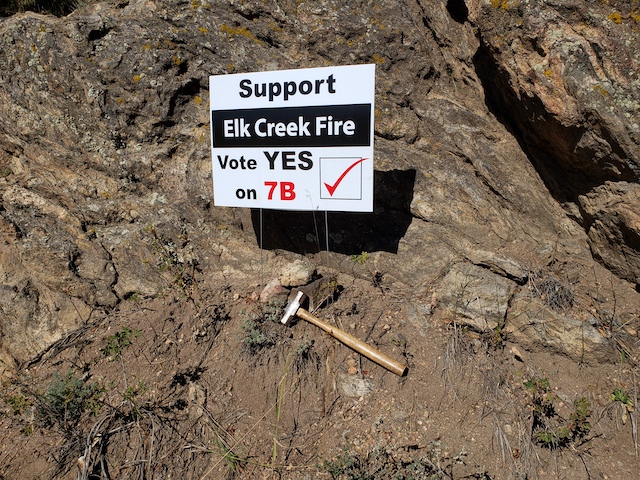- Posts: 43
- Thank you received: 1
- Forum
- The Highway
- The Courthouse
- Vote YES for Elk Creek Fire Protection District's November 2019 Mill Levy
Vote YES for Elk Creek Fire Protection District's November 2019 Mill Levy
- ASaferConifer
-
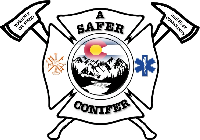 Topic Author
Topic Author
- Happy Camper
-

The district's budget reductions are due to the effects of the Gallagher Amendment which adjusts the amounts of property tax collected to stay within the 45% residential/55% commercial split, resulting in a cut to ECFPD's budget because property values have increased but our district doesn't have the commercial property to balance it out.The Elk Creek Fire Protection District will lay off at least one full-time staffer, table needed equipment upgrades and implement several budget cuts next year after the Gallagher Amendment significantly reduced the district’s expected property tax revenue for 2018.
According to Fire Chief Bill McLaughlin, the amendment effectively reduced the district’s property tax revenue by about $150,000, which will result in the elimination of a paramedic position, delayed replacement of needed cardiac monitors in the department’s ambulances and the delayed replacement of at least one ambulance.
“It’s the biggest thing affecting our budget,” said McLaughlin. “Our property taxes are going up five percent (in 2018). If the Gallagher Amendment were not going into affect, that (revenue) would have gone up 15 to 18 percent, and that’s the difference between cutting that paramedic position and the new ambulance, or being able to keep those things. … We’re also cutting our fitness program and we’re scaling back on training programs. We were able to put two people through paramedic school last year, for example, and we can’t do that in 2018.”
This video has what’s probably the best explanation of the Gallagher Amendment’s effects on our fire dept:
Our situation isn't this dire, but if Elk Creek Fire has to lay off it's paid firefighter/paramedics and discontinue ambulance services in order to stay within their budget, then the level of care will be reduced for everyone's emergencies.
What if you call 911 and no one comes?
Inside the collapse of America's emergency medical services
By Erika Edwards
Oct. 22 2019
The night of June 15, 2016, was perfect for a softball game in Hebron, North Dakota. The temperature had reached almost 80 degrees that day, and even though Jerrid Soupir had been feeling pretty lousy — like maybe he was catching a summer cold — he was itching to get out on the field.
It was a doubleheader that night. Soupir, then 46, was playing shortstop in the second game. He remembers helping his teammates make a double play, getting two players out.
He turned to walk back to his position, went limp and fell straight to the ground.
Soupir had gone into cardiac arrest, meaning his heart stopped working suddenly. It’s often fatal if the victim doesn’t get help quickly.
There is no hospital in Hebron. In fact, when someone calls 911, there isn’t even a law that requires anyone in Hebron to answer the phone. Like so many other low-income, rural communities across the country, the small town’s ambulance runs on altruism alone.
And those ambulance services are closing in record numbers, putting around 60 million Americans at risk of being stranded in a medical emergency. Because so many emergency medical services (EMS) agencies have been struggling financially, some states are stepping in with funding. But emergency medical experts say it’s not enough to cure the dire situation.
Please Vote YES on 7B!
PO Box 353, Conifer, CO 80433
Email: This email address is being protected from spambots. You need JavaScript enabled to view it.
A Safer Conifer Facebook Page
Please Log in or Create an account to join the conversation.
- ASaferConifer
-
 Topic Author
Topic Author
- Happy Camper
-

- Posts: 43
- Thank you received: 1
The link to Elk Creek Fire's 2020 First Draft budget is here: elkcreekfire.org/wp-content/uploads/budg...rrative-10062019.pdf
The previous budgets, all audited, are here: elkcreekfire.org/transparency/
Please look it over and call the station to talk to Chief McLaughlin or Deputy Chief Ware if you have questions. (303) 816-9385 The next Board of Directors monthly meeting is November 14th at 6:00pm at Station 1, 11993 Blackfoot Rd.
PO Box 353, Conifer, CO 80433
Email: This email address is being protected from spambots. You need JavaScript enabled to view it.
A Safer Conifer Facebook Page
Please Log in or Create an account to join the conversation.
- ASaferConifer
-
 Topic Author
Topic Author
- Happy Camper
-

- Posts: 43
- Thank you received: 1
What happens if the levy doesn’t pass? The fire department can’t just not respond, can it?
If voters don’t pass the mill levy, the fire department will do everything possible to maintain services, but some fire protection and ambulance services may be cut back or eliminated.
Simultaneous Calls
We often take it for granted that if we call 911, we will get help quickly, but this is not a guarantee, particularly in the mountains. If you are the second or third call, your wait time will almost always be longer. So far this year, there have been 181 calls that came in while at least one other call was already going on; that is 17.9% of all calls. So on average, when you call 911, your chances of a crew already being out are higher than 1 in 6.
If your home is burning or a family member is ill or injured, how much are those minutes worth?
Home Insurance and ISO Ratings
Home insurance coverage and ratings are partially based on the distance your home is from a fire station. It may not be feasible to maintain all four stations going forward. If one or more volunteer stations (St. 2, 3, and 4) close, it would negatively impact the ISO rating for homes farther than five miles from a station, which could result in increased insurance premiums and more difficultly in getting or keeping insurance. Homes more than five miles from a fire station are rated at 10 (“Unprotected,” on a scale of 1 to 10). elkcreekfire.org/iso-information/
How was the number of mills decided on?
This is the amount that will provide the fire department with the resources to meet the needs of the community, including adequate staffing and equipment, wildland fire mitigation programs, water supply systems, and fire stations (the locations of which can impact homeowner’s insurance rates).
How does Elk Creek compare to the surrounding districts?
Elk Creek has a much lower mill amount than the surrounding districts, at 7.47. Other districts in the area include Evergreen, Inter-canyon, Platte Canyon, Indian Hills, and North Fork; their mill amounts vary between 12 and 14.29 mills. When looking at the actual revenue, it’s important to remember that call volume and other costs aren’t equal across the districts, so even though Elk Creek’s revenue is higher than some, the number of calls and the associated costs are also higher than others.
How do they spend the money they receive now? Can’t they be more efficient in how they use the money they have?
Transparency
The Board of Directors and the chiefs at Elk Creek carefully consider how the money is spent and take responsibility for spending it wisely. The budget for each year, salaries, and spending are all public record and can be found online at www.elkcreekfire.org/transparency
Grants, Cuts, Bottom Line
The department has applied for grants, bought vehicles from other departments that were upgrading, and has had to put off repairs to stations and water cisterns due to lack of funding. Efficiency is important, but when the funding simply isn’t enough to meet the need, efficiency can’t solve the problem.
Department Mergers
One of the best ways to increase efficiency is by combining services with other departments. When neighboring departments combine, they can reduce the number of stations, fire engines and ambulances, and administrative personnel, creating lower overhead costs. Elk Creek’s mill levy amount and relative budget are so far behind the neighboring districts though, that if the mill levy doesn’t pass, merger talks are unlikely to continue because tax payers from neighboring districts would be making up the difference.
Even if ECFD’s mill amount is lower than other districts, the revenue is higher than some in the area. Why isn’t it enough?
It’s important to remember that call volume and other costs aren’t equal across the districts, so even though Elk Creek’s revenue is higher than some, the number of calls and the associated costs are also higher.
I don’t want to pay for people coming from out of town. Is that why we need the levy?
The call volume is increasing, due to more residents as well as more visitors. For visitors, think of it as reciprocity. If you go into Denver and are in a car crash, a metro fire department will respond. If you go on vacation in another state and get hurt, the local department will come. And if your family comes to visit and has an emergency, Elk Creek will provide the same service for them as they would for someone who lives here.
If people want to give money to the fire department, they can make a donation. Why should they get to decide how I spend my own money? I’d rather just pay for a service if I need it.
Donations would not be enough to maintain a fire department, and while many people might rather pay for a private ambulance if they need one, consider the cost of a structure fire, or a wildfire, or a vehicle rescue. Most people would not be able to pay these costs. This is even more true for wildfires.
Investing in the fire department is like an insurance policy: you’re paying for something you hope you never need, but if you do, you need the insurance too. For example, potential expenses for a house fire could include:
- 4+ people (usually more), anywhere from 1 to 10 or more hours: putting out the fire and additional hours for cleaning hoses and equipment to get the apparatus back in service
- Specialized engines and other apparatus, which are expensive to purchase and maintain, and must be tested regularly
- Specialized tools, nozzles, and other equipment
- Firefighter gear and air packs
- Water and fuel
- Station(s) to house equipment and personnel, utilities, computers, software
- Radios, maps
- Training
- Insurance
Have other districts put mill levies on recent ballots? What about revenue stabilization measures?
Mill Levy Measures
Yes. In 2018, Inter-Canyon’s mill levy took the district from 10.56 to 13.56.
Revenue Stabilization Measures
Several other local districts passed measures for revenue stabilization (to de-Gallagherize) in Nov. 2018, including:
North Fork Fire Protection District - passed with 81.4% of the vote
Platte Canyon – passed with 71.88%
Indian Hills – (etc.) 71.65%
Evergreen – 68.68%
West Metro – 69.79%
Arvada – 73.01%
Fairmount – 66.79%
Sources:
www.jeffco.us/DocumentCenter/View/15102/...-Protection-District
www.jeffco.us/DocumentCenter/View/15098/...-Protection-District
evergreenfirerescue.com/wp-content/uploa...-Ballot-Question.pdf
arvadapress.com/stories/west-metro-fire-...llot-issue-7c,272847 ?
www.arvadafire.com/Election/UpdatedFAQ.pdf
www.jeffco.us/DocumentCenter/View/15097/...-Protection-District
2018 Results and percentages:
Jeffco: results.enr.clarityelections.com/CO/Jeff...1809/Web02.222611/#/
ParkCo: parkco.us/DocumentCenter/View/5126/2018-...ral-Election-Results
Elk Creek considered a similar measure, but the mill levy is the more urgent priority and it was felt that having two measures on the ballot at the same time could have a negative impact on passing the levy. Until revenue has caught up to the needs of the district and can provide for the immediate future, revenue stabilization would not be adequate and was therefore tabled for this election.
What about the 2013 mill levy? Why is there another one?
The 2013 mill levy was the first increase in decades. Voters chose against approving funding in multiple previous levies. Because of this, it was decided in the 2013 levy to increase the mills to a very modest amount rather than trying to catch up all at once. The district has been under strain to maintain services on the current budget, so it was decided to run this levy to be able to continue meeting the needs of the community. The 2013 levy also contains a “sunset clause,” so it will expire in 2023 and the mills will go back down.
Like the mill amount, the sunset clause was decided on because of the need for voters to the pass the levy. While the levy passed, Elk Creek Fire continues to have the lowest mill levy rate in the Front Range and it was only a temporary measure to get by; this 2019 levy will catch Elk Creek Fire up to the surrounding districts and to the funding needed to meet the needs of the community, particularly as it is continuing to grow.
BOTTOM LINE
Residents of the district must decide how much emergency help they want to have available. The bottom line is there can only be as much service as there is funding for it, and the people who vote on the mill levy decide this.
Please Vote YES on 7B!
PO Box 353, Conifer, CO 80433
Email: This email address is being protected from spambots. You need JavaScript enabled to view it.
A Safer Conifer Facebook Page
Please Log in or Create an account to join the conversation.
- ASaferConifer
-
 Topic Author
Topic Author
- Happy Camper
-

- Posts: 43
- Thank you received: 1
PO Box 353, Conifer, CO 80433
Email: This email address is being protected from spambots. You need JavaScript enabled to view it.
A Safer Conifer Facebook Page
Please Log in or Create an account to join the conversation.
- ASaferConifer
-
 Topic Author
Topic Author
- Happy Camper
-

- Posts: 43
- Thank you received: 1
Without the mill levy to cover the costs of those two programs, they will not return next season. In addition, should Jeffco 1A not pass, it is possible that the county's Slash Program may be drastically cut back or discontinued as they face a $16M budget cut, and residents would be left with only Park County to take their slash.
These programs of Elk Creek Fire's have not cost taxpayers a thing up to this point, but ECFPD no longer has that option and it's worth funding for the benefit it provides us all. Please vote YES on 7B to help retain the Chipping Program and the Wildland Module Crew!
PO Box 353, Conifer, CO 80433
Email: This email address is being protected from spambots. You need JavaScript enabled to view it.
A Safer Conifer Facebook Page
Please Log in or Create an account to join the conversation.
- ASaferConifer
-
 Topic Author
Topic Author
- Happy Camper
-

- Posts: 43
- Thank you received: 1
To everyone one who volunteered as a Friend of Elk Creek Fire and worked tirelessly to create flyers, put up signs, went around to businesses and handed out flyers and posters, stood outside on street corners and waved to passersby, went door to door and spoke with neighbors, who shared our posts and answered questions - you are so appreciated. To the firefighter membership who donated so generously so we could fund this campaign, we couldn't have done it without your help. You all rock every day serving our community and we are grateful beyond words.
To our community, our deepest gratitude. Your faith in our fire department and support of our firefighters is heartwarming and we are so grateful. We encourage you all to become more involved, attend Board meetings, ask questions, or volunteer!
PO Box 353, Conifer, CO 80433
Email: This email address is being protected from spambots. You need JavaScript enabled to view it.
A Safer Conifer Facebook Page
Please Log in or Create an account to join the conversation.
- ASaferConifer
-
 Topic Author
Topic Author
- Happy Camper
-

- Posts: 43
- Thank you received: 1
PO Box 353, Conifer, CO 80433
Email: This email address is being protected from spambots. You need JavaScript enabled to view it.
A Safer Conifer Facebook Page
Please Log in or Create an account to join the conversation.
- ElkCreekFireDepartment
-
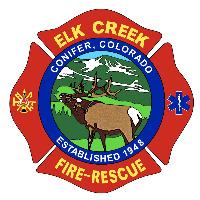
- Mountain Legend
-

Our hearts are overflowing today. Words can't truly express our utmost gratitude in the faith you have demonstrated in us in voting for the mill levy in overwhelming fashion. We are humbled by, and deeply appreciate, your support of our firefighters, volunteers, and staff. Thank you ever so much!
In case of emergency, please dial 911.
elkcreekfpd.colorado.gov/
Facebook Page
303-816-9385 (Office Hours M-F 8:00-4:30)
This email address is being protected from spambots. You need JavaScript enabled to view it.
Please Log in or Create an account to join the conversation.
- Forum
- The Highway
- The Courthouse
- Vote YES for Elk Creek Fire Protection District's November 2019 Mill Levy


